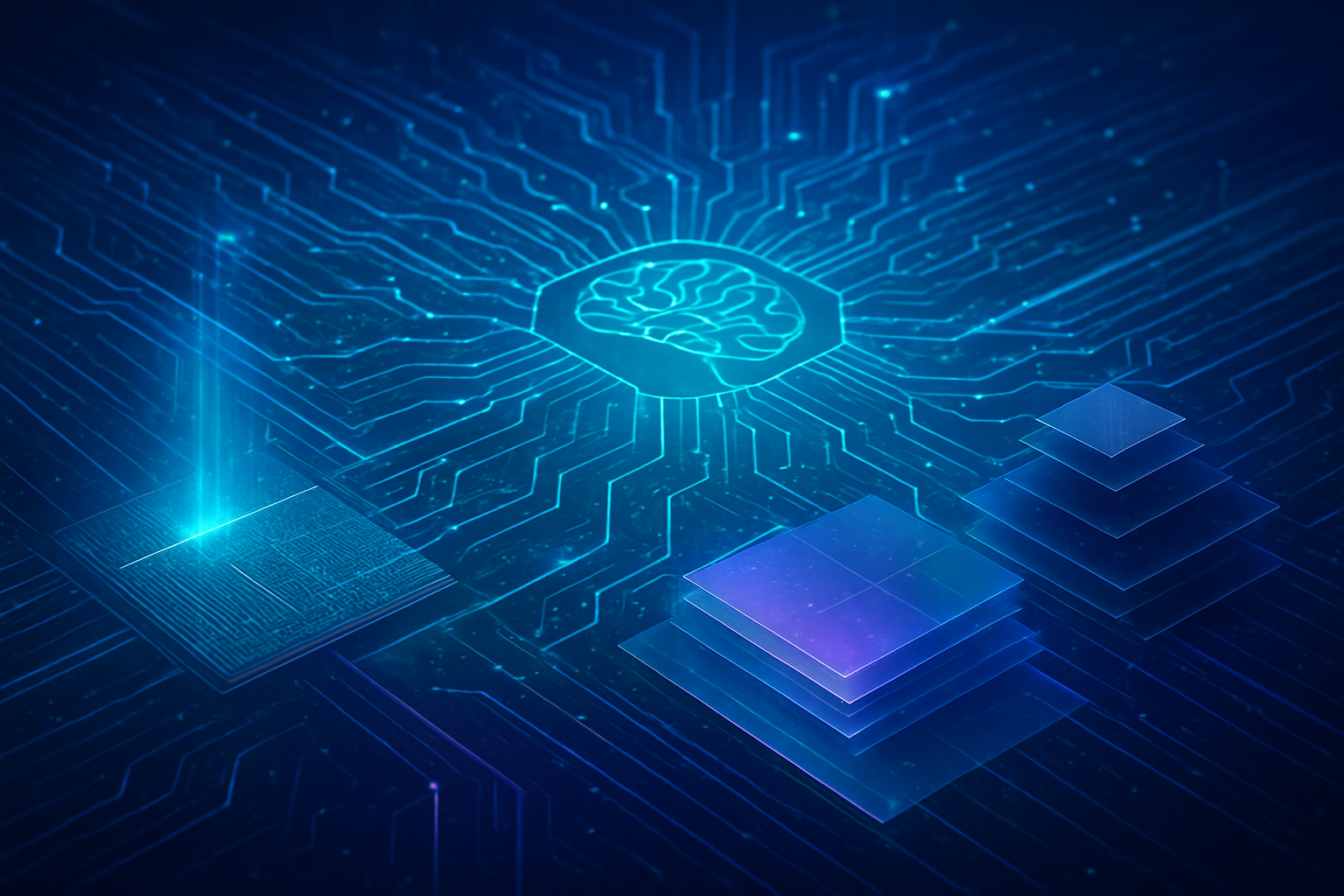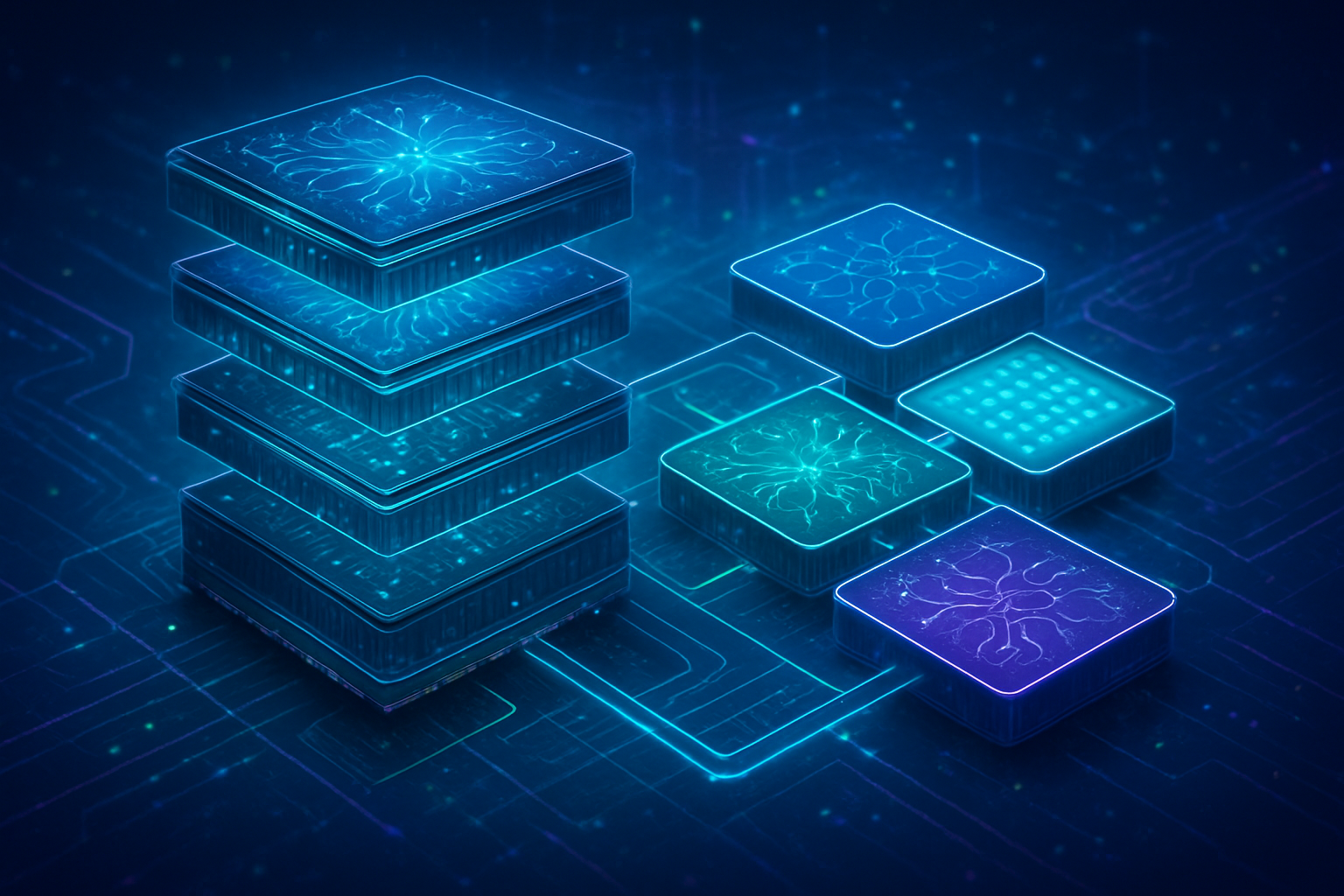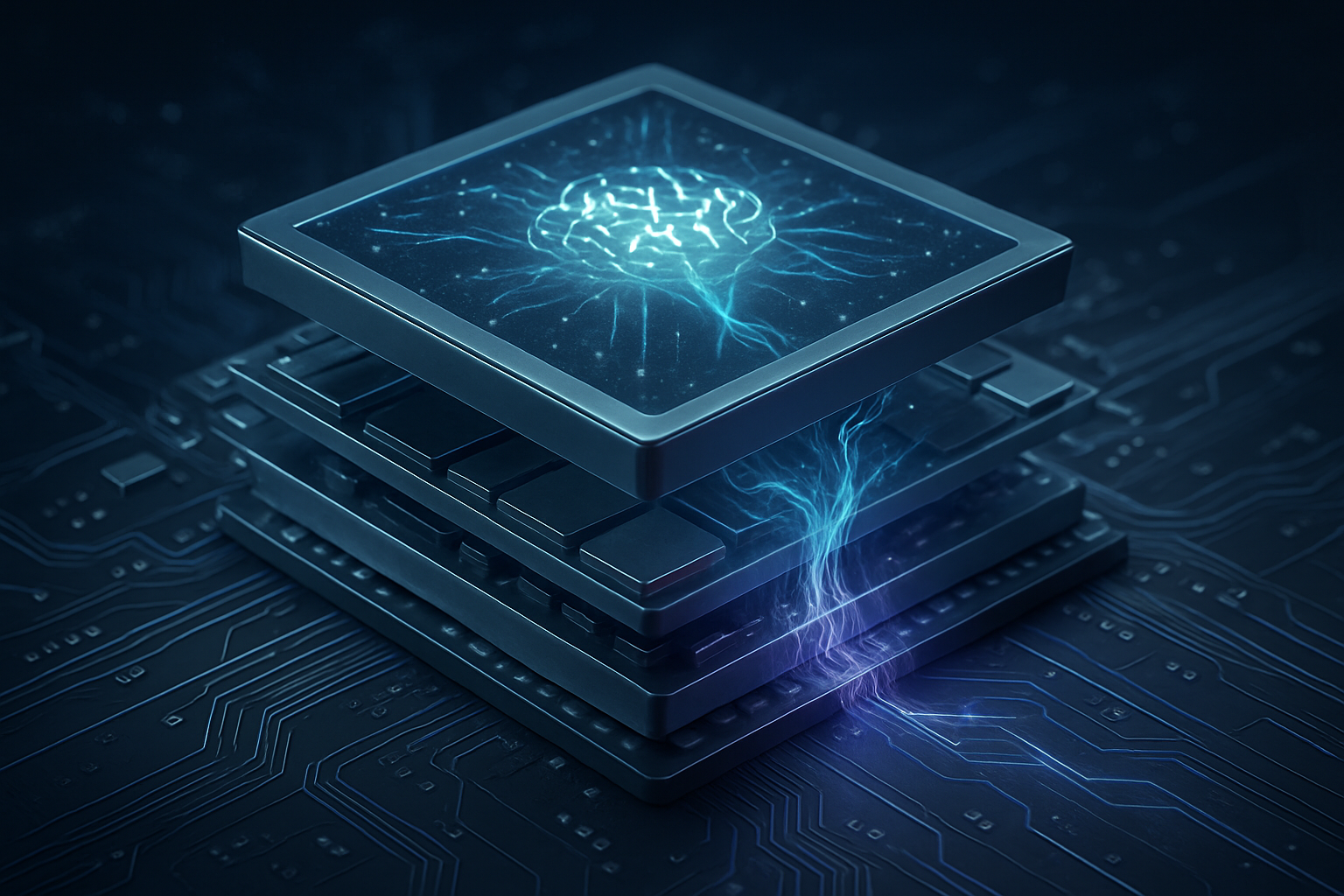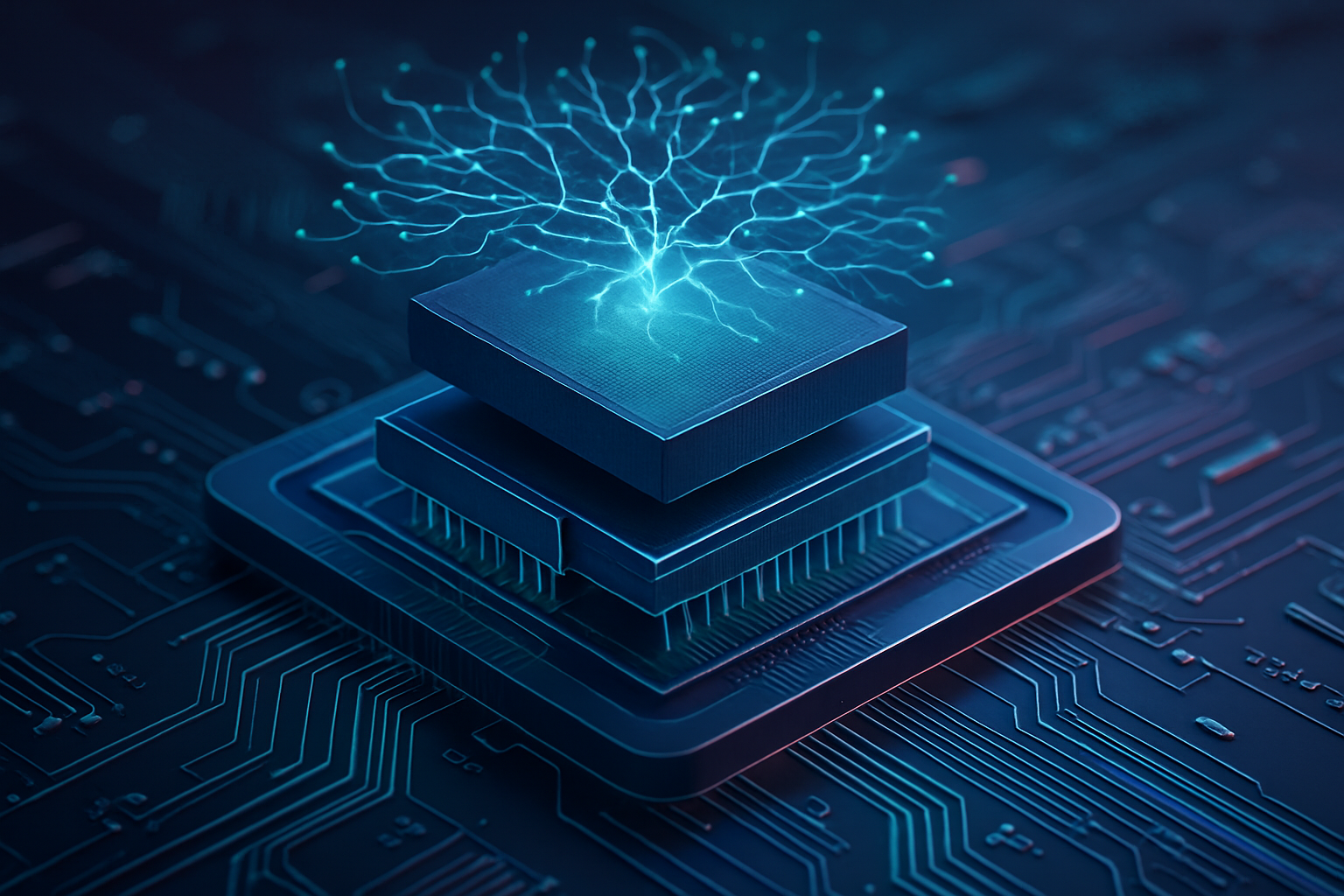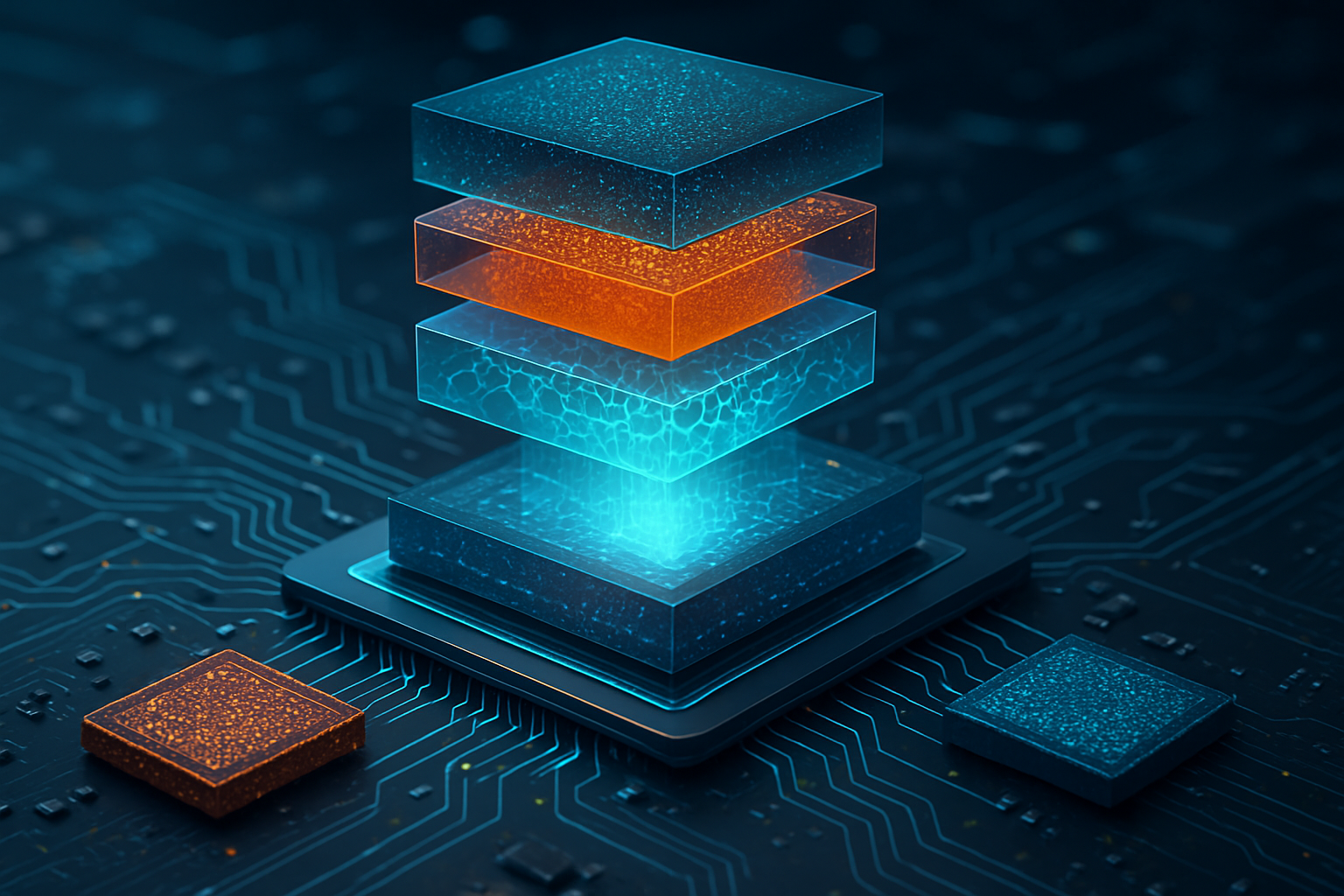The semiconductor industry is on the cusp of a revolutionary transformation, moving beyond the long-standing dominance of silicon to unlock unprecedented capabilities in computing. This shift is driven by the escalating demands of artificial intelligence (AI), 5G/6G communications, electric vehicles (EVs), and quantum computing, all of which are pushing silicon to its inherent physical limits in miniaturization, power consumption, and thermal management. Emerging semiconductor technologies, focusing on novel materials and advanced architectures, are poised to redefine chip design and manufacturing, ushering in an era of hyper-efficient, powerful, and specialized computing previously unattainable.
Innovations poised to reshape the tech industry in the near future include wide-bandgap (WBG) materials like Gallium Nitride (GaN) and Silicon Carbide (SiC), which offer superior electrical efficiency, higher electron mobility, and better heat resistance for high-power applications, critical for EVs, 5G infrastructure, and data centers. Complementing these are two-dimensional (2D) materials such as graphene and Molybdenum Disulfide (MoS2), providing pathways to extreme miniaturization, enhanced electrostatic control, and even flexible electronics due to their atomic thinness. Beyond current FinFET transistor designs, new architectures like Gate-All-Around FETs (GAA-FETs, including nanosheets and nanoribbons) and Complementary FETs (CFETs) are becoming critical, enabling superior channel control and denser, more energy-efficient chips required for next-generation logic at 2nm nodes and beyond. Furthermore, advanced packaging techniques like chiplets and 3D stacking, along with the integration of silicon photonics for faster data transmission, are becoming essential to overcome bandwidth limitations and reduce energy consumption in high-performance computing and AI workloads. These advancements are not merely incremental improvements; they represent a fundamental re-evaluation of foundational materials and structures, enabling entirely new classes of AI applications, neuromorphic computing, and specialized processing that will power the next wave of technological innovation.
The Technical Core: Unpacking the Next-Gen Semiconductor Innovations
The semiconductor industry is undergoing a profound transformation driven by the escalating demands for higher performance, greater energy efficiency, and miniaturization beyond the limits of traditional silicon-based architectures. Emerging semiconductor technologies, encompassing novel materials, advanced transistor designs, and innovative packaging techniques, are poised to reshape the tech industry, particularly in the realm of artificial intelligence (AI).
Wide-Bandgap Materials: Gallium Nitride (GaN) and Silicon Carbide (SiC)
Gallium Nitride (GaN) and Silicon Carbide (SiC) are wide-bandgap (WBG) semiconductors that offer significant advantages over conventional silicon, especially in power electronics and high-frequency applications. Silicon has a bandgap of approximately 1.1 eV, while SiC boasts about 3.3 eV and GaN an even wider 3.4 eV. This larger energy difference allows WBG materials to sustain much higher electric fields before breakdown, handling nearly ten times higher voltages and operating at significantly higher temperatures (typically up to 200°C vs. silicon's 150°C). This improved thermal performance leads to better heat dissipation and allows for simpler, smaller, and lighter packaging. Both GaN and SiC exhibit higher electron mobility and saturation velocity, enabling switching frequencies up to 10 times higher than silicon, resulting in lower conduction and switching losses and efficiency improvements of up to 70%.
While both offer significant improvements, GaN and SiC serve different power applications. SiC devices typically withstand higher voltages (1200V and above) and higher current-carrying capabilities, making them ideal for high-power applications such as automotive and locomotive traction inverters, large solar farms, and three-phase grid converters. GaN excels in high-frequency applications and lower power levels (up to a few kilowatts), offering superior switching speeds and lower losses, suitable for DC-DC converters and voltage regulators in consumer electronics and advanced computing.
2D Materials: Graphene and Molybdenum Disulfide (MoS₂)
Two-dimensional (2D) materials, only a few atoms thick, present unique properties for next-generation electronics. Graphene, a semimetal with a zero-electron bandgap, exhibits exceptional electrical and thermal conductivity, mechanical strength, flexibility, and optical transparency. Its high conductivity makes it promising for transparent conductive oxides and interconnects. However, its zero bandgap restricts its direct application in optoelectronics and field-effect transistors where a clear on/off switching characteristic is required.
Molybdenum Disulfide (MoS₂), a transition metal dichalcogenide (TMDC), has a direct bandgap of 1.8 eV in its monolayer form. Unlike graphene, MoS₂'s natural bandgap makes it highly suitable for applications requiring efficient light absorption and emission, such as photodetectors, LEDs, and solar cells. MoS₂ monolayers have shown strong performance in 5nm electronic devices, including 2D MoS₂-based field-effect transistors and highly efficient photodetectors. Integrating MoS₂ and graphene creates hybrid systems that leverage the strengths of both, for instance, in high-efficiency solar cells or as ohmic contacts for MoS₂ transistors.
Advanced Architectures: Gate-All-Around FETs (GAA-FETs) and Complementary FETs (CFETs)
As traditional planar transistors reached their scaling limits, FinFETs emerged as 3D structures. FinFETs utilize a fin-shaped channel surrounded by the gate on three sides, offering improved electrostatic control and reduced leakage. However, at 3nm and below, FinFETs face challenges due to increasing variability and limitations in scaling metal pitch.
Gate-All-Around FETs (GAA-FETs) overcome these limitations by having the gate fully enclose the entire channel on all four sides, providing superior electrostatic control and significantly reducing leakage and short-channel effects. GAA-FETs, typically constructed using stacked nanosheets, allow for a vertical form factor and continuous variation of channel width, offering greater design flexibility and improved drive current. They are emerging at 3nm and are expected to be dominant at 2nm and below.
Complementary FETs (CFETs) are a potential future evolution beyond GAA-FETs, expected beyond 2030. CFETs dramatically reduce the footprint area by vertically stacking n-type MOSFET (nMOS) and p-type MOSFET (pMOS) transistors, allowing for much higher transistor density and promising significant improvements in power, performance, and area (PPA).
Advanced Packaging: Chiplets, 3D Stacking, and Silicon Photonics
Advanced packaging techniques are critical for continuing performance scaling as Moore's Law slows down, enabling heterogeneous integration and specialized functionalities, especially for AI workloads.
Chiplets are small, specialized dies manufactured using optimal process nodes for their specific function. Multiple chiplets are assembled into a multi-chiplet module (MCM) or System-in-Package (SiP). This modular approach significantly improves manufacturing yields, allows for heterogeneous integration, and can lead to 30-40% lower energy consumption. It also optimizes cost by using cutting-edge nodes only where necessary.
3D stacking involves vertically integrating multiple semiconductor dies or wafers using Through-Silicon Vias (TSVs) for vertical electrical connections. This dramatically shortens interconnect distances. 2.5D packaging places components side-by-side on an interposer, increasing bandwidth and reducing latency. True 3D packaging stacks active dies vertically using hybrid bonding, achieving even greater integration density, higher I/O density, reduced signal propagation delays, and significantly lower latency. These solutions can reduce system size by up to 70% and improve overall computing performance by up to 10 times.
Silicon photonics integrates optical and electronic components on a single silicon chip, using light (photons) instead of electrons for data transmission. This enables extremely high bandwidth and low power consumption. In AI, silicon photonics, particularly through Co-Packaged Optics (CPO), is replacing copper interconnects to reduce power and latency in multi-rack AI clusters and data centers, addressing bandwidth bottlenecks for high-performance AI systems.
Initial Reactions from the AI Research Community and Industry Experts
The AI research community and industry experts have shown overwhelmingly positive reactions to these emerging semiconductor technologies. They are recognized as critical for fueling the next wave of AI innovation, especially given AI's increasing demand for computational power, vast memory bandwidth, and ultra-low latency. Experts acknowledge that traditional silicon scaling (Moore's Law) is reaching its physical limits, making advanced packaging techniques like 3D stacking and chiplets crucial solutions. These innovations are expected to profoundly impact various sectors, including autonomous vehicles, IoT, 5G/6G networks, cloud computing, and advanced robotics. Furthermore, AI itself is not only a consumer but also a catalyst for innovation in semiconductor design and manufacturing, with AI algorithms accelerating material discovery, speeding up design cycles, and optimizing power efficiency.
Corporate Battlegrounds: How Emerging Semiconductors Reshape the Tech Industry
The rapid evolution of Artificial Intelligence (AI) is heavily reliant on breakthroughs in semiconductor technology. Emerging technologies like wide-bandgap materials, 2D materials, Gate-All-Around FETs (GAA-FETs), Complementary FETs (CFETs), chiplets, 3D stacking, and silicon photonics are reshaping the landscape for AI companies, tech giants, and startups by offering enhanced performance, power efficiency, and new capabilities.
Wide-Bandgap Materials: Powering the AI Infrastructure
WBG materials (GaN, SiC) are crucial for power management in energy-intensive AI data centers, allowing for more efficient power delivery to AI accelerators and reducing operational costs. Companies like Nvidia (NASDAQ: NVDA) are already partnering to deploy GaN in 800V HVDC architectures for their next-generation AI processors. Tech giants like Google (NASDAQ: GOOGL), Meta (NASDAQ: META), and AMD (NASDAQ: AMD) will be major consumers for their custom silicon. Navitas Semiconductor (NASDAQ: NVTS) is a key beneficiary, validated as a critical supplier for AI infrastructure through its partnership with Nvidia. Other players like Wolfspeed (NYSE: WOLF), Infineon Technologies (FWB: IFX) (which acquired GaN Systems), ON Semiconductor (NASDAQ: ON), and STMicroelectronics (NYSE: STM) are solidifying their positions. Companies embracing WBG materials will have more energy-efficient and powerful AI systems, displacing silicon in power electronics and RF applications.
2D Materials: Miniaturization and Novel Architectures
2D materials (graphene, MoS2) promise extreme miniaturization, enabling ultra-low-power, high-density computing and in-sensor memory for AI. Major foundries like TSMC (NYSE: TSM) and Intel (NASDAQ: INTC) are heavily investing in their research and integration. Startups like Graphenea and Haydale Graphene Industries specialize in producing these nanomaterials. Companies successfully integrating 2D materials for ultra-fast, energy-efficient transistors will gain significant market advantages, although these are a long-term solution to scaling limits.
Advanced Transistor Architectures: The Core of Future Chips
GAA-FETs and CFETs are critical for continuing miniaturization and enhancing the performance and power efficiency of AI processors. Foundries like TSMC, Samsung (KRX: 005930), and Intel are at the forefront of developing and implementing these, making their ability to master these nodes a key competitive differentiator. Tech giants designing custom AI chips will leverage these advanced nodes. Startups may face high entry barriers due to R&D costs, but advanced EDA tools from companies like Siemens (FWB: SIE) and Synopsys (NASDAQ: SNPS) will be crucial. Foundries that successfully implement these earliest will attract top AI chip designers.
Chiplets: Modular Innovation for AI
Chiplets enable the creation of highly customized, powerful, and energy-efficient AI accelerators by integrating diverse, purpose-built processing units. This modular approach optimizes cost and improves energy efficiency. Tech giants like Google, Amazon (NASDAQ: AMZN), and Microsoft (NASDAQ: MSFT) are heavily reliant on chiplets for their custom AI chips. AMD has been a pioneer, and Intel is heavily invested with its IDM 2.0 strategy. Broadcom (NASDAQ: AVGO) is also developing 3.5D packaging. Chiplets significantly lower the barrier to entry for specialized AI hardware development for startups. This technology fosters an "infrastructure arms race," challenging existing monopolies like Nvidia's dominance.
3D Stacking: Overcoming the Memory Wall
3D stacking vertically integrates multiple layers of chips to enhance performance, reduce power, and increase storage capacity. This, especially with High Bandwidth Memory (HBM), is critical for AI accelerators, dramatically increasing bandwidth between processing units and memory. AMD (Instinct MI300 series), Intel (Foveros), Nvidia, Samsung, Micron (NASDAQ: MU), and SK Hynix (KRX: 000660) are heavily investing in this. Foundries like TSMC, Intel, and Samsung are making massive investments in advanced packaging, with TSMC dominating. Companies like Micron are becoming key memory suppliers for AI workloads. This is a foundational enabler for sustaining AI innovation beyond Moore's Law.
Silicon Photonics: Ultra-Fast, Low-Power Interconnects
Silicon photonics uses light for data transmission, enabling high-speed, low-power communication. This directly addresses the "bandwidth wall" for real-time AI processing and large language models. Tech giants like Google, Amazon, and Microsoft, invested in cloud AI services, benefit immensely for their data center interconnects. Startups focusing on optical I/O chiplets, like Ayar Labs, are emerging as leaders. Silicon photonics is positioned to solve the "twin crises" of power consumption and bandwidth limitations in AI, transforming the switching layer in AI networks.
Overall Competitive Implications and Disruption
The competitive landscape is being reshaped by an "infrastructure arms race" driven by advanced packaging and chiplet integration, challenging existing monopolies. Tech giants are increasingly designing their own custom AI chips, directly challenging general-purpose GPU providers. A severe talent shortage in semiconductor design and manufacturing is exacerbating competition for specialized talent. The industry is shifting from monolithic to modular chip designs, and the energy efficiency imperative is pushing existing inefficient products towards obsolescence. Foundries (TSMC, Intel Foundry Services, Samsung Foundry) and companies providing EDA tools (Arm (NASDAQ: ARM) for architectures, Siemens, Synopsys, Cadence (NASDAQ: CDNS)) are crucial. Memory innovators like Micron and SK Hynix are critical, and strategic partnerships are vital for accelerating adoption.
The Broader Canvas: AI's Symbiotic Dance with Advanced Semiconductors
Emerging semiconductor technologies are fundamentally reshaping the landscape of artificial intelligence, enabling unprecedented computational power, efficiency, and new application possibilities. These advancements are critical for overcoming the physical and economic limitations of traditional silicon-based architectures and fueling the current "AI Supercycle."
Fitting into the Broader AI Landscape
The relationship between AI and semiconductors is deeply symbiotic. AI's explosive growth, especially in generative AI and large language models (LLMs), is the primary catalyst driving unprecedented demand for smaller, faster, and more energy-efficient semiconductors. These emerging technologies are the engine powering the next generation of AI, enabling capabilities that would be impossible with traditional silicon. They fit into several key AI trends:
-
Beyond Moore's Law: As traditional transistor scaling slows, these technologies, particularly chiplets and 3D stacking, provide alternative pathways to continued performance gains.
-
Heterogeneous Computing: Combining different processor types with specialized memory and interconnects is crucial for optimizing diverse AI workloads, and emerging semiconductors enable this more effectively.
-
Energy Efficiency: The immense power consumption of AI necessitates hardware innovations that significantly improve energy efficiency, directly addressed by wide-bandbandgap materials and silicon photonics.
-
Memory Wall Breakthroughs: AI workloads are increasingly memory-bound. 3D stacking with HBM is directly addressing the "memory wall" by providing massive bandwidth, critical for LLMs.
-
Edge AI: The demand for real-time AI processing on devices with minimal power consumption drives the need for optimized chips using these advanced materials and packaging techniques.
-
AI for Semiconductors (AI4EDA): AI is not just a consumer but also a powerful tool in the design, manufacturing, and optimization of semiconductors themselves, creating a powerful feedback loop.
Impacts and Potential Concerns
Positive Impacts: These innovations deliver unprecedented performance, significantly faster processing, higher data throughput, and lower latency, directly translating to more powerful and capable AI models. They bring enhanced energy efficiency, greater customization and flexibility through chiplets, and miniaturization for widespread AI deployment. They also open new AI frontiers like neuromorphic computing and quantum AI, driving economic growth.
Potential Concerns: The exorbitant costs of innovation, requiring billions in R&D and state-of-the-art fabrication facilities, create high barriers to entry. Physical and engineering challenges, such as heat dissipation and managing complexity at nanometer scales, remain difficult. Supply chain vulnerability, due to extreme concentration of advanced manufacturing, creates geopolitical risks. Data scarcity for AI in manufacturing, and integration/compatibility issues with new hardware architectures, also pose hurdles. Despite efficiency gains, the sheer scale of AI models means overall electricity consumption for AI is projected to rise dramatically, posing a significant sustainability challenge. Ethical concerns about workforce disruption, privacy, bias, and misuse of AI also become more pressing.
Comparison to Previous AI Milestones
The current advancements are ushering in an "AI Supercycle" comparable to previous transformative periods. Unlike past milestones often driven by software on existing hardware, this era is defined by deep co-design between AI algorithms and specialized hardware, representing a more profound shift. The relationship is deeply symbiotic, with AI driving hardware innovation and vice versa. These technologies are directly tackling fundamental physical and architectural bottlenecks (Moore's Law limits, memory wall, power consumption) that previous generations faced. The trend is towards highly specialized AI accelerators, often enabled by chiplets and 3D stacking, leading to unprecedented efficiency. The scale of modern AI is vastly greater, necessitating these innovations. A distinct difference is the emergence of AI being used to accelerate semiconductor development and manufacturing itself.
The Horizon: Charting the Future of Semiconductor Innovation
Emerging semiconductor technologies are rapidly advancing to meet the escalating demand for more powerful, energy-efficient, and compact electronic devices. These innovations are critical for driving progress in fields like artificial intelligence (AI), automotive, 5G/6G communication, and high-performance computing (HPC).
Wide-Bandgap Materials (SiC and GaN)
Near-Term (1-5 years): Continued optimization of manufacturing processes for SiC and GaN, increasing wafer sizes (e.g., to 200mm SiC wafers), and reducing production costs will enable broader adoption. SiC is expected to gain significant market share in EVs, power electronics, and renewable energy.
Long-Term (Beyond 5 years): WBG semiconductors, including SiC and GaN, will largely replace traditional silicon in power electronics. Further integration with advanced packaging will maximize performance. Diamond (Dia) is emerging as a future ultrawide bandgap semiconductor.
Applications: EVs (inverters, motor drives, fast charging), 5G/6G infrastructure, renewable energy systems, data centers, industrial power conversion, aerospace, and consumer electronics (fast chargers).
Challenges: High production costs, material quality and reliability, lack of standardized norms, and limited production capabilities.
Expert Predictions: SiC will become indispensable for electrification. The WBG technology market is expected to boom, projected to reach around $24.5 billion by 2034.
2D Materials
Near-Term (1-5 years): Continued R&D, with early adopters implementing them in niche applications. Hybrid approaches with silicon or WBG semiconductors might be initial commercialization pathways. Graphene is already used in thermal management.
Long-Term (Beyond 5 years): 2D materials are expected to become standard components in high-performance and next-generation devices, enabling ultra-dense, energy-efficient transistors at atomic scales and monolithic 3D integration. They are crucial for logic applications.
Applications: Ultra-fast, energy-efficient chips (graphene as optical-electronic translator), advanced transistors (MoS2, InSe), flexible and wearable electronics, high-performance sensors, neuromorphic computing, thermal management, and quantum photonics.
Challenges: Scalability of high-quality production, compatible fabrication techniques, material stability (degradation by moisture/oxygen), cost, and integration with silicon.
Expert Predictions: Crucial for future IT, enabling breakthroughs in device performance. The global 2D materials market is projected to reach $4,000 million by 2031, growing at a CAGR of 25.3%.
Gate-All-Around FETs (GAA-FETs) and Complementary FETs (CFETs)
Near-Term (1-5 years): GAA-FETs are critical for shrinking transistors beyond 3nm and 2nm nodes, offering superior electrostatic control and reduced leakage. The industry is transitioning to GAA-FETs.
Long-Term (Beyond 5 years): Exploration of innovative designs like U-shaped FETs and CFETs as successors. CFETs are expected to offer even greater density and efficiency by vertically stacking n-type and p-type GAA-FETs. Research into alternative materials for channels is also on the horizon.
Applications: HPC, AI processors, low-power logic systems, mobile devices, and IoT.
Challenges: Fabrication complexities, heat dissipation, leakage currents, material compatibility, and scalability issues.
Expert Predictions: GAA-FETs are pivotal for future semiconductor technologies, particularly for low-power logic systems, HPC, and AI domains.
Chiplets
Near-Term (1-5 years): Broader adoption beyond high-end CPUs and GPUs. The Universal Chiplet Interconnect Express (UCIe) standard is expected to mature, fostering a robust ecosystem. Advanced packaging (2.5D, 3D hybrid bonding) will become standard for HPC and AI, alongside intensified adoption of HBM4.
Long-Term (Beyond 5 years): Fully modular semiconductor designs with custom chiplets optimized for specific AI workloads will dominate. Transition from 2.5D to more prevalent 3D heterogeneous computing. Co-packaged optics (CPO) are expected to replace traditional copper interconnects.
Applications: HPC and AI hardware (specialized accelerators, breaking memory wall), CPUs and GPUs, data centers, autonomous vehicles, networking, edge computing, and smartphones.
Challenges: Standardization (UCIe addressing this), complex thermal management, robust testing methodologies for multi-vendor ecosystems, design complexity, packaging/interconnect technology, and supply chain coordination.
Expert Predictions: Chiplets will be found in almost all high-performance computing systems, becoming ubiquitous in AI hardware. The global chiplet market is projected to reach hundreds of billions of dollars.
3D Stacking
Near-Term (1-5 years): Rapid growth driven by demand for enhanced performance. TSMC (NYSE: TSM), Samsung, and Intel are leading this trend. Quick move towards glass substrates to replace current 2.5D and 3D packaging between 2026 and 2030.
Long-Term (Beyond 5 years): Increasingly prevalent for heterogeneous computing, integrating different functional layers directly on a single chip. Further miniaturization and integration with quantum computing and photonics. More cost-effective solutions.
Applications: HPC and AI (higher memory density, high-performance memory, quantum-optimized logic), mobile devices and wearables, data centers, consumer electronics, and automotive.
Challenges: High manufacturing complexity, thermal management, yield challenges, high cost, interconnect technology, and supply chain.
Expert Predictions: Rapid growth in the 3D stacking market, with projections ranging from reaching USD 9.48 billion by 2033 to USD 3.1 billion by 2028.
Silicon Photonics
Near-Term (1-5 years): Robust growth driven by AI and datacom transceiver demand. Arrival of 3.2Tbps transceivers by 2026. Innovation will involve monolithic integration using quantum dot lasers.
Long-Term (Beyond 5 years): Pivotal role in next-generation computing, with applications in high-bandwidth chip-to-chip interconnects, advanced packaging, and co-packaged optics (CPO) replacing copper. Programmable photonics and photonic quantum computers.
Applications: AI data centers, telecommunications, optical interconnects, quantum computing, LiDAR systems, healthcare sensors, photonic engines, and data storage.
Challenges: Material limitations (achieving optical gain/lasing in silicon), integration complexity (high-powered lasers), cost management, thermal effects, lack of global standards, and production lead times.
Expert Predictions: Market projected to grow significantly (44-45% CAGR between 2022-2028/2029). AI is a major driver. Key players will emerge, and China is making strides towards global leadership.
The AI Supercycle: A Comprehensive Wrap-Up of Semiconductor's New Era
Emerging semiconductor technologies are rapidly reshaping the landscape of modern computing and artificial intelligence, driving unprecedented innovation and projected market growth to a trillion dollars by the end of the decade. This transformation is marked by advancements across materials, architectures, packaging, and specialized processing units, all converging to meet the escalating demands for faster, more efficient, and intelligent systems.
Key Takeaways
The core of this revolution lies in several synergistic advancements: advanced transistor architectures like GAA-FETs and the upcoming CFETs, pushing density and efficiency beyond FinFETs; new materials such as Gallium Nitride (GaN) and Silicon Carbide (SiC), which offer superior power efficiency and thermal performance for demanding applications; and advanced packaging technologies including 2.5D/3D stacking and chiplets, enabling heterogeneous integration and overcoming traditional scaling limits by creating modular, highly customized systems. Crucially, specialized AI hardware—from advanced GPUs to neuromorphic chips—is being developed with these technologies to handle complex AI workloads. Furthermore, quantum computing, though nascent, leverages semiconductor breakthroughs to explore entirely new computational paradigms. The Universal Chiplet Interconnect Express (UCIe) standard is rapidly maturing to foster interoperability in the chiplet ecosystem, and High Bandwidth Memory (HBM) is becoming the "scarce currency of AI," with HBM4 pushing the boundaries of data transfer speeds.
Significance in AI History
Semiconductors have always been the bedrock of technological progress. In the context of AI, these emerging technologies mark a pivotal moment, driving an "AI Supercycle." They are not just enabling incremental gains but are fundamentally accelerating AI capabilities, pushing beyond the limits of Moore's Law through innovative architectural and packaging solutions. This era is characterized by a deep hardware-software symbiosis, where AI's immense computational demands directly fuel semiconductor innovation, and in turn, these hardware advancements unlock new AI models and applications. This also facilitates the democratization of AI, allowing complex models to run on smaller, more accessible edge devices. The intertwining evolution is so profound that AI is now being used to optimize semiconductor design and manufacturing itself.
Long-Term Impact
The long-term impact of these emerging semiconductor technologies will be transformative, leading to ubiquitous AI seamlessly integrated into every facet of life, from smart cities to personalized healthcare. A strong focus on energy efficiency and sustainability will intensify, driven by materials like GaN and SiC and eco-friendly production methods. Geopolitical factors will continue to reshape global supply chains, fostering more resilient and regionally focused manufacturing. New frontiers in computing, particularly quantum AI, promise to tackle currently intractable problems. Finally, enhanced customization and functionality through advanced packaging will broaden the scope of electronic devices across various industrial applications. The transition to glass substrates for advanced packaging between 2026 and 2030 is also a significant long-term shift to watch.
What to Watch For in the Coming Weeks and Months
The semiconductor landscape remains highly dynamic. Key areas to monitor include:
- Manufacturing Process Node Updates: Keep a close eye on progress in the 2nm race and Angstrom-class (1.6nm, 1.8nm) technologies from leading foundries like TSMC (NYSE: TSM) and Intel (NASDAQ: INTC), focusing on their High Volume Manufacturing (HVM) timelines and architectural innovations like backside power delivery.
- Advanced Packaging Capacity Expansion: Observe the aggressive expansion of advanced packaging solutions, such as TSMC's CoWoS and other 3D IC technologies, which are crucial for next-generation AI accelerators.
- HBM Developments: High Bandwidth Memory remains critical. Watch for updates on new HBM generations (e.g., HBM4), customization efforts, and its increasing share of the DRAM market, with revenue projected to double in 2025.
- AI PC and GenAI Smartphone Rollouts: The proliferation of AI-capable PCs and GenAI smartphones, driven by initiatives like Microsoft's (NASDAQ: MSFT) Copilot+ baseline, represents a substantial market shift for edge AI processors.
- Government Incentives and Supply Chain Shifts: Monitor the impact of government incentives like the US CHIPS and Science Act, as investments in domestic manufacturing are expected to become more evident from 2025, reshaping global supply chains.
- Neuromorphic Computing Progress: Look for breakthroughs and increased investment in neuromorphic chips that mimic brain-like functions, promising more energy-efficient and adaptive AI at the edge.
The industry's ability to navigate the complexities of miniaturization, thermal management, power consumption, and geopolitical influences will determine the pace and direction of future innovations.
This content is intended for informational purposes only and represents analysis of current AI developments.
TokenRing AI delivers enterprise-grade solutions for multi-agent AI workflow orchestration, AI-powered development tools, and seamless remote collaboration platforms. For more information, visit https://www.tokenring.ai/.


